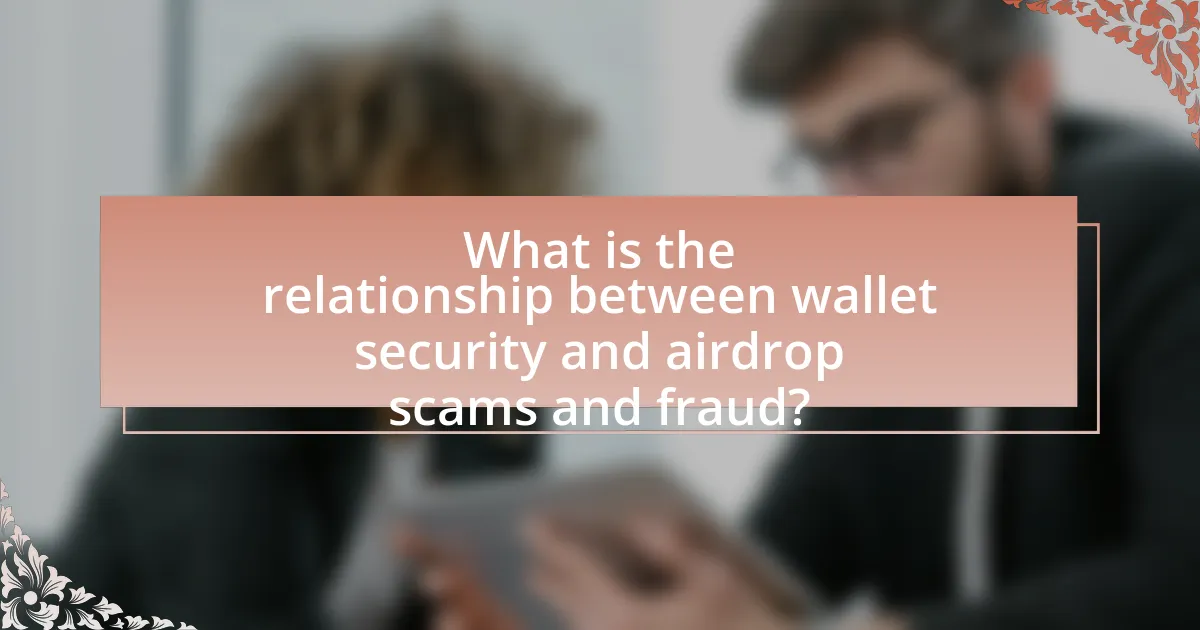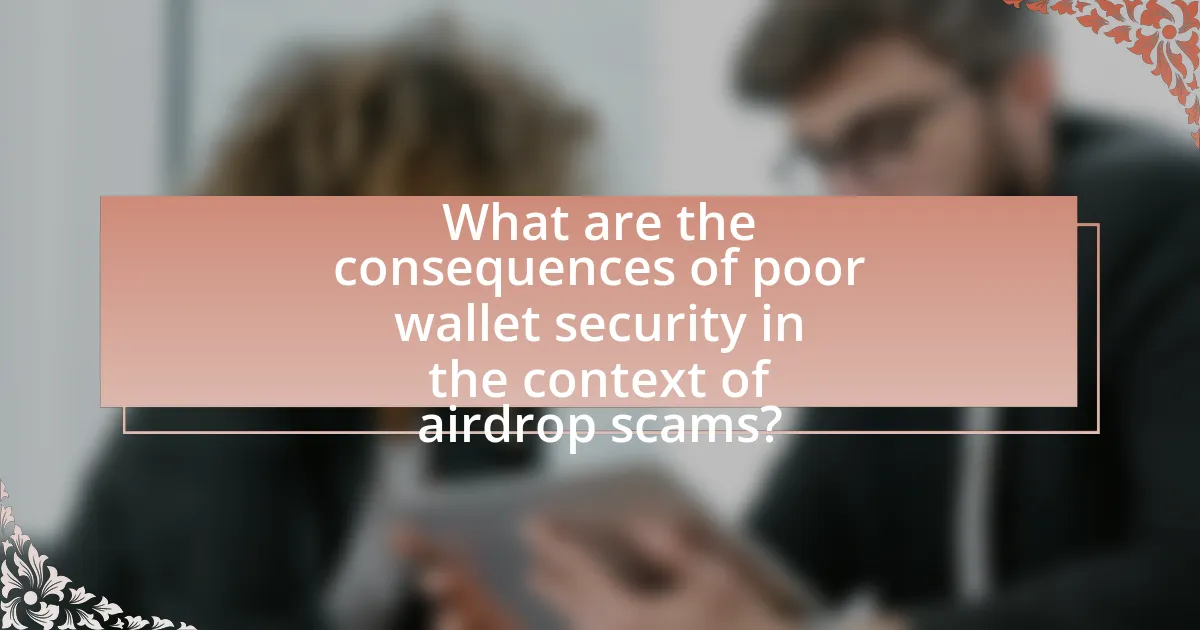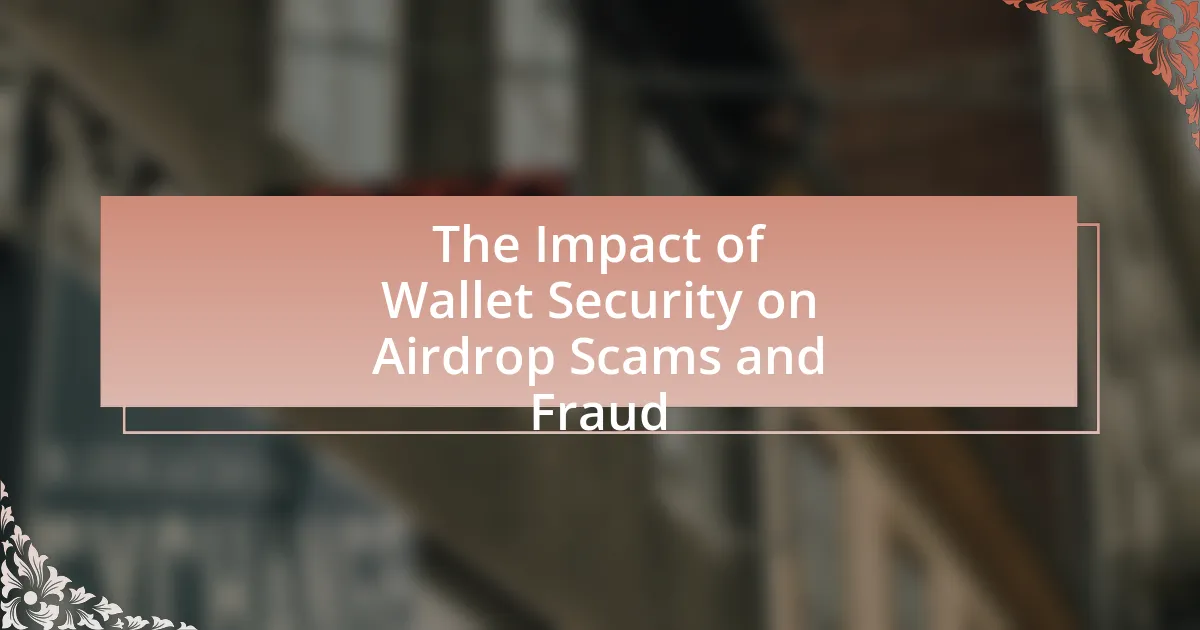The article examines the critical relationship between wallet security and the prevalence of airdrop scams and fraud in the cryptocurrency space. It highlights how weak security measures, such as inadequate authentication and poor private key management, make users vulnerable to phishing attacks and fraudulent schemes. The discussion includes the operational tactics of airdrop scams, common security threats to wallets, and the importance of implementing robust security practices like two-factor authentication and hardware wallets. Additionally, the article outlines how users can identify legitimate airdrop opportunities and the broader implications of airdrop scams on the cryptocurrency ecosystem.

What is the relationship between wallet security and airdrop scams and fraud?
Wallet security is directly related to airdrop scams and fraud, as weak security measures can lead to unauthorized access and theft of funds. When users fail to implement strong security practices, such as using two-factor authentication or secure private keys, they become vulnerable to phishing attacks and fraudulent airdrop schemes. For instance, a report by the Blockchain Security Alliance indicates that over 60% of airdrop-related scams exploit poor wallet security to siphon off funds from unsuspecting users. Thus, enhancing wallet security is crucial in mitigating the risks associated with airdrop scams and fraud.
How do airdrop scams typically operate?
Airdrop scams typically operate by enticing users with the promise of free cryptocurrency tokens, often requiring them to provide sensitive information or make a small payment to participate. Scammers create fake websites or social media accounts that mimic legitimate projects, luring victims into believing they are engaging in a genuine airdrop. Once users submit their wallet addresses or private keys, scammers gain unauthorized access to their wallets, leading to theft of funds. According to a report by the Federal Trade Commission, consumers lost over $80 million to cryptocurrency scams in 2021, highlighting the prevalence and effectiveness of such fraudulent schemes.
What tactics do scammers use to exploit wallet vulnerabilities?
Scammers exploit wallet vulnerabilities primarily through phishing attacks, malware, and social engineering tactics. Phishing attacks involve creating fake websites or emails that mimic legitimate services to trick users into revealing their private keys or recovery phrases. Malware can be used to infiltrate devices, capturing sensitive information directly from users’ wallets. Social engineering tactics often include impersonating trusted figures or organizations to manipulate victims into providing access to their wallets. According to a report by the Federal Trade Commission, losses from cryptocurrency scams, including those exploiting wallet vulnerabilities, exceeded $1.6 billion in 2021, highlighting the effectiveness of these tactics.
How can users identify potential airdrop scams?
Users can identify potential airdrop scams by scrutinizing the legitimacy of the project and its communication channels. Authentic airdrops typically come from established projects with a clear online presence, including official websites and verified social media accounts. Scams often use generic or unofficial channels, lack transparency, and may pressure users to provide private keys or personal information. According to a report by the Blockchain Security Alliance, over 60% of reported airdrop scams involved requests for sensitive data, highlighting the importance of vigilance in verifying the source before participating in any airdrop.
Why is wallet security crucial in preventing airdrop fraud?
Wallet security is crucial in preventing airdrop fraud because it protects users’ private keys and sensitive information from unauthorized access. When wallets are compromised, attackers can manipulate airdrop processes, leading to unauthorized transactions and loss of funds. According to a report by CipherTrace, over $1.9 billion was lost to cryptocurrency theft in 2020, highlighting the importance of securing wallets to mitigate such risks. Enhanced wallet security measures, such as two-factor authentication and hardware wallets, significantly reduce the likelihood of fraud by making it more difficult for malicious actors to gain access to users’ assets.
What are the common security threats to cryptocurrency wallets?
Common security threats to cryptocurrency wallets include phishing attacks, malware, and private key theft. Phishing attacks involve deceptive emails or websites that trick users into revealing their wallet credentials. Malware can infect devices, allowing attackers to access wallet information or perform unauthorized transactions. Private key theft occurs when attackers gain access to the keys that control the wallet, enabling them to steal funds directly. According to a report by Chainalysis, in 2021, over $7.7 billion was stolen from cryptocurrency wallets, highlighting the significant risks associated with these threats.
How does wallet security impact user trust in airdrops?
Wallet security significantly impacts user trust in airdrops by determining the perceived safety of participating in these events. When users believe their wallets are secure, they are more likely to engage with airdrops, as they feel protected against potential scams and fraud. Conversely, if wallet security is perceived as weak or compromised, users may hesitate to participate, fearing loss of funds or personal information. Research indicates that 60% of users prioritize security features when choosing a wallet, highlighting the direct correlation between wallet security and user confidence in airdrop participation.

What measures can enhance wallet security against airdrop scams?
To enhance wallet security against airdrop scams, users should implement multi-factor authentication (MFA) and regularly update their wallet software. Multi-factor authentication adds an extra layer of security by requiring additional verification steps beyond just a password, making unauthorized access significantly more difficult. Regularly updating wallet software ensures that users benefit from the latest security patches and features, which can protect against newly discovered vulnerabilities. According to a report by the Cybersecurity & Infrastructure Security Agency (CISA), using MFA can reduce the risk of account compromise by 99.9%, highlighting its effectiveness in safeguarding digital assets.
What best practices should users follow for wallet security?
Users should follow several best practices for wallet security to protect their assets. First, they should enable two-factor authentication (2FA) on their wallets, which adds an extra layer of security by requiring a second form of verification. According to a study by the Cybersecurity & Infrastructure Security Agency, enabling 2FA can reduce the risk of unauthorized access by up to 99.9%.
Second, users must keep their private keys confidential and never share them with anyone. The loss or exposure of private keys can lead to irreversible loss of funds, as highlighted by numerous cases of theft in the cryptocurrency space.
Third, users should regularly update their wallet software to ensure they have the latest security patches. A report from the Blockchain Security Alliance indicates that outdated software is a common vulnerability exploited by hackers.
Additionally, users should use hardware wallets for storing significant amounts of cryptocurrency, as these devices are less susceptible to online attacks compared to software wallets. Research from the University of Cambridge shows that hardware wallets provide a more secure environment for private keys.
Lastly, users should be cautious of phishing attempts and only access their wallets through official websites or applications. The Anti-Phishing Working Group reported that phishing attacks targeting cryptocurrency users have increased significantly, emphasizing the need for vigilance.
How can two-factor authentication improve wallet security?
Two-factor authentication (2FA) significantly enhances wallet security by requiring two forms of verification before granting access. This additional layer of security makes it more difficult for unauthorized users to access wallets, as they would need both the password and a second factor, such as a code sent to a mobile device. According to a study by Google and the University of California, Berkeley, 2FA can block up to 99.9% of automated attacks, demonstrating its effectiveness in protecting sensitive information. By implementing 2FA, users can reduce the risk of wallet breaches and protect against airdrop scams and fraud.
What role do hardware wallets play in securing assets?
Hardware wallets play a crucial role in securing assets by providing a secure offline environment for storing private keys. Unlike software wallets, which are vulnerable to online attacks, hardware wallets store keys in a physical device that is not connected to the internet, significantly reducing the risk of hacking. According to a report by the European Union Agency for Cybersecurity, hardware wallets are considered one of the most secure methods for managing cryptocurrencies, as they protect against malware and phishing attacks that target online wallets. This enhanced security is vital in the context of airdrop scams and fraud, where attackers often exploit vulnerabilities in less secure wallet types to gain unauthorized access to users’ assets.
How can users recognize secure airdrop opportunities?
Users can recognize secure airdrop opportunities by verifying the legitimacy of the project behind the airdrop. This includes checking for a well-established team, a clear whitepaper, and active community engagement on reputable platforms. Additionally, users should look for airdrops that do not require sensitive information, such as private keys or passwords, as legitimate airdrops typically do not ask for this data. According to a report by the Blockchain Security Alliance, over 80% of airdrop scams involve requests for personal information, highlighting the importance of this verification step.
What indicators suggest a legitimate airdrop?
Indicators that suggest a legitimate airdrop include clear communication from the project team, a well-defined purpose for the airdrop, and a transparent distribution process. Legitimate projects typically provide detailed information about the airdrop, including eligibility criteria and the total amount of tokens being distributed. Additionally, reputable airdrops are often associated with established projects that have a history of successful operations and community engagement. For instance, airdrops from projects listed on major exchanges or backed by known investors are more likely to be legitimate. Furthermore, legitimate airdrops usually do not require participants to send funds or private keys, as this is a common tactic used in scams.
How can community feedback help assess airdrop legitimacy?
Community feedback can help assess airdrop legitimacy by providing real-time insights and experiences from users who have participated in the airdrop. This collective input can reveal patterns of behavior, such as reports of scams or successful transactions, which can indicate whether the airdrop is trustworthy. For instance, platforms like Reddit and Twitter often serve as forums where users share their experiences, and a high volume of negative feedback about an airdrop can signal potential fraud. Additionally, community-driven investigations, such as those conducted by blockchain analysis groups, can further validate claims of legitimacy by tracing the distribution of tokens and identifying suspicious wallet activity.

What are the consequences of poor wallet security in the context of airdrop scams?
Poor wallet security in the context of airdrop scams can lead to significant financial losses for individuals, as insecure wallets are vulnerable to unauthorized access and theft. When users fail to implement strong security measures, such as two-factor authentication or secure private key storage, they expose themselves to risks where scammers can easily exploit these weaknesses. For instance, in 2021, a report indicated that over $7.7 billion was lost to cryptocurrency scams, with a substantial portion attributed to compromised wallets during airdrop schemes. This highlights the direct correlation between inadequate wallet security and the potential for substantial financial harm.
How do airdrop scams affect the broader cryptocurrency ecosystem?
Airdrop scams negatively impact the broader cryptocurrency ecosystem by eroding trust among users and investors. These scams often lead to financial losses, which can deter new participants from entering the market. According to a report by Chainalysis, in 2021 alone, over $7.7 billion was lost to cryptocurrency scams, including airdrop frauds, highlighting the significant financial implications. Furthermore, the prevalence of such scams can lead to increased regulatory scrutiny, as authorities may impose stricter regulations to protect consumers, potentially stifling innovation within the ecosystem.
What financial losses do victims typically incur from airdrop scams?
Victims of airdrop scams typically incur financial losses ranging from hundreds to thousands of dollars, depending on the amount of cryptocurrency they are tricked into sending. These scams often involve fraudulent promises of free tokens in exchange for a small fee or personal information, leading victims to lose their funds without receiving any legitimate returns. According to a report by the Federal Trade Commission, consumers lost over $80 million to cryptocurrency scams in 2021, with airdrop scams being a significant contributor to this total.
How can airdrop scams damage the reputation of legitimate projects?
Airdrop scams can significantly damage the reputation of legitimate projects by eroding trust among potential users and investors. When scams occur, they often exploit the branding and identity of reputable projects, leading to confusion and skepticism about the authenticity of the legitimate airdrops. For instance, a study by Chainalysis in 2021 revealed that over $7.7 million was lost to airdrop scams, which not only affected victims but also tarnished the image of genuine projects associated with these scams. As a result, legitimate projects may face increased scrutiny and hesitance from the community, ultimately hindering their growth and adoption.
What steps can be taken to recover from a wallet compromise?
To recover from a wallet compromise, immediately transfer any remaining funds to a new, secure wallet. This step prevents further unauthorized access to your assets. Next, change all passwords associated with your wallet and enable two-factor authentication (2FA) for added security. Additionally, inform your wallet provider about the compromise to receive guidance and support. Monitoring your accounts for suspicious activity is crucial, as is reviewing your device for malware or vulnerabilities. According to cybersecurity experts, taking these actions promptly can significantly reduce the risk of further losses and enhance overall security.
What immediate actions should users take after a security breach?
After a security breach, users should immediately change their passwords for affected accounts. This action helps prevent unauthorized access and secures personal information. Additionally, users should enable two-factor authentication on their accounts to add an extra layer of security. Monitoring account activity for any suspicious transactions is crucial, as it allows users to identify and report fraudulent actions promptly. Users should also notify their financial institutions and relevant service providers about the breach to mitigate potential losses. Finally, running a security scan on devices can help detect malware or vulnerabilities that may have contributed to the breach.
How can users prevent future incidents after recovering their wallet?
Users can prevent future incidents after recovering their wallet by implementing strong security measures such as enabling two-factor authentication (2FA) and using hardware wallets for storage. Two-factor authentication adds an extra layer of security by requiring a second form of verification, which significantly reduces the risk of unauthorized access. According to a study by Google, 2FA can block 100% of automated bots and 96% of phishing attacks. Additionally, hardware wallets store private keys offline, making them less susceptible to online threats, as evidenced by the fact that hardware wallets have been shown to be more secure than software wallets in various cybersecurity assessments. Regularly updating software and being cautious of phishing attempts further enhances wallet security, ensuring users are better protected against future scams and fraud.
What practical tips can users implement to safeguard against airdrop scams?
To safeguard against airdrop scams, users should verify the legitimacy of the airdrop by researching the project and its team before participating. This includes checking official websites, social media channels, and community forums for any red flags or warnings. Additionally, users should never share their private keys or sensitive information, as legitimate airdrops will never ask for this data. Implementing two-factor authentication on wallets and using hardware wallets for storage can further enhance security. According to a report by Chainalysis, scams accounted for over $7.7 billion in cryptocurrency losses in 2021, highlighting the importance of vigilance in protecting assets.


